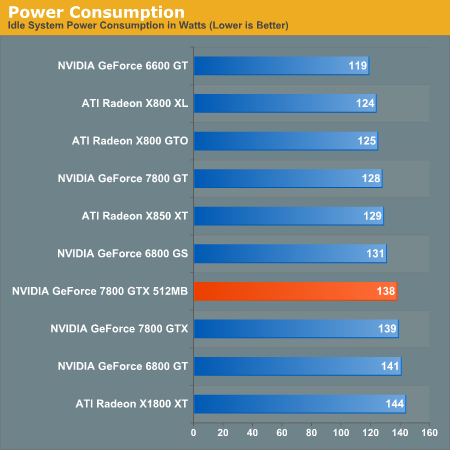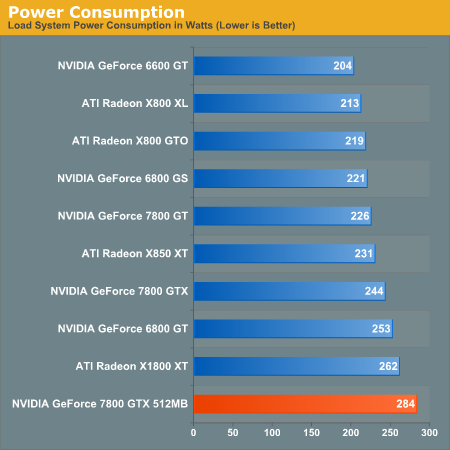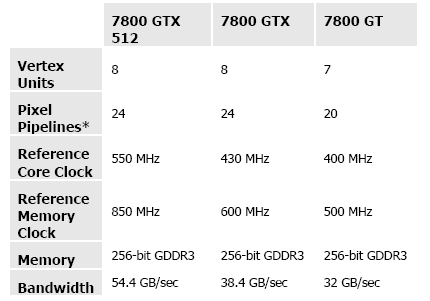NVIDIA GeForce 7800 GTX 512: More Than Just More Memory
by Derek Wilson on November 14, 2005 9:00 AM EST- Posted in
- GPUs
The Card, The Test, and Power
There are a few key changes from the original 7800 GTX silicon that allow the 7800 GTX 512 to perform so highly. The 7800 GTX 512 still uses a 110nm process like the original 7800 GTX, but NVIDIA has tuned their fab process to speed up key data paths in the chip. These enhancements, while not altering the feature set in anyway, allow the chip to reach clock speeds of 550MHz (which is 120MHz faster than the original 7800 GTX). On top of changes in the silicon, the 7800 GTX 512 has gotten a PCB revision. And just in case anyone is wondering, the huge HSF solution is actually very quiet. NVIDIA is using a fan with larger blades that move a good volume of air without needing to run at super high RPMs. While it may look like an industrial sized leaf blower, it bark is certainly nothing compared to the bite this thing takes out of our performance tests.
Current 7800 GTX cards feature 8Mx32 GDDR3 with four chips on each side of the PCB. Most cards have a heat spreader on the back of the board, while some vendors have attached heatsinks. NVIDIA needed a better way to cool their RAM in order to hit the memory clock speeds they wanted. To this end the 7800 GTX 512 sees all of its RAM on the front of the PCB cooled by the very large heatsink previously employed on the Quadro FX 4500. Moving all the RAM to one side of the PCB may also have improved the routing to certain memory modules, which would also help increase attainable stable memory clock speeds. There are still only 8 modules total, as NVIDIA has also moved to higher density 16Mx32 GDDR3. The RAM used is also rated at 900MHz (1800MHz data rate), giving the stock memory clock speed of 1700MHz a little head room for vendors who like to overclock the cards they sell.
Here is a quick comparison of NVIDIA's 7800 series line up with the new GTX 512:
Slower architectures have the advantage of being less effected by latency as a long clock cycle time allows data to move further per cycle. At the same time, to compete with high frequency processing, much more work has to get done per clock cycle than a faster chip. Graphics tend to lend themselves to this type of architecture, which is partly why we haven't seen multiple-GHz graphics chips.
In any case, increasing core and memory clocks, framebuffer size, and adding a gigantic HSF will certainly require a little more power than the standard 7800 GTX. NVIDIA currently still recommends the same types of power supplies for the 7800 GTX 512 as it does for the 7800 GTX, but, as we can see from our tests, the 7800 GTX 512 does result in a much higher power draw from the wall. In fact, the outlets in our lab had some trouble getting consistent power to our PSU during SLI testing. Most people won't run into a problem like this unless they run quite a few PCs off the same circuit breaker at home. We actually had to solve our problem by running one of the 7800 GTX 512 cards off of a second power supply plugged into an extension cord running off of a different circuit. If nothing else, this setup could help people test for wiring problems in their homes.
These power numbers are measured at the wall before the PSU.


Certainly the 7800 GTX 512 is a power hog to say the least. Unfortunately, we didn't have a reliable way to test power draw for the 7800 GTX 512 SLI setup, but if we ever get around to rewiring the lab ...
Let's take a look at the hardware we will use.
Test Hardware
This is definitely a powerful system we will be examining today. For our benchmarks, we test with sound disabled. Most of these tests are timedemos played back using ingame functionality, but the Black & White 2 benchmark is a FRAPS test using an ingame cut scene. We will provide bar graphs for the very popular 1600x1200 resolution while reporting data from 1280x960 to 2048x1536 in resolution scaling graphs.
There are a few key changes from the original 7800 GTX silicon that allow the 7800 GTX 512 to perform so highly. The 7800 GTX 512 still uses a 110nm process like the original 7800 GTX, but NVIDIA has tuned their fab process to speed up key data paths in the chip. These enhancements, while not altering the feature set in anyway, allow the chip to reach clock speeds of 550MHz (which is 120MHz faster than the original 7800 GTX). On top of changes in the silicon, the 7800 GTX 512 has gotten a PCB revision. And just in case anyone is wondering, the huge HSF solution is actually very quiet. NVIDIA is using a fan with larger blades that move a good volume of air without needing to run at super high RPMs. While it may look like an industrial sized leaf blower, it bark is certainly nothing compared to the bite this thing takes out of our performance tests.
Current 7800 GTX cards feature 8Mx32 GDDR3 with four chips on each side of the PCB. Most cards have a heat spreader on the back of the board, while some vendors have attached heatsinks. NVIDIA needed a better way to cool their RAM in order to hit the memory clock speeds they wanted. To this end the 7800 GTX 512 sees all of its RAM on the front of the PCB cooled by the very large heatsink previously employed on the Quadro FX 4500. Moving all the RAM to one side of the PCB may also have improved the routing to certain memory modules, which would also help increase attainable stable memory clock speeds. There are still only 8 modules total, as NVIDIA has also moved to higher density 16Mx32 GDDR3. The RAM used is also rated at 900MHz (1800MHz data rate), giving the stock memory clock speed of 1700MHz a little head room for vendors who like to overclock the cards they sell.
Here is a quick comparison of NVIDIA's 7800 series line up with the new GTX 512:

Slower architectures have the advantage of being less effected by latency as a long clock cycle time allows data to move further per cycle. At the same time, to compete with high frequency processing, much more work has to get done per clock cycle than a faster chip. Graphics tend to lend themselves to this type of architecture, which is partly why we haven't seen multiple-GHz graphics chips.
In any case, increasing core and memory clocks, framebuffer size, and adding a gigantic HSF will certainly require a little more power than the standard 7800 GTX. NVIDIA currently still recommends the same types of power supplies for the 7800 GTX 512 as it does for the 7800 GTX, but, as we can see from our tests, the 7800 GTX 512 does result in a much higher power draw from the wall. In fact, the outlets in our lab had some trouble getting consistent power to our PSU during SLI testing. Most people won't run into a problem like this unless they run quite a few PCs off the same circuit breaker at home. We actually had to solve our problem by running one of the 7800 GTX 512 cards off of a second power supply plugged into an extension cord running off of a different circuit. If nothing else, this setup could help people test for wiring problems in their homes.
These power numbers are measured at the wall before the PSU.


Certainly the 7800 GTX 512 is a power hog to say the least. Unfortunately, we didn't have a reliable way to test power draw for the 7800 GTX 512 SLI setup, but if we ever get around to rewiring the lab ...
Let's take a look at the hardware we will use.
Test Hardware
| CPU: | AMD Athlon 64 FX-57 (2.8GHz) |
| Motherboard: | ASUS A8N32-SLI Deluxe |
| Chipset: | NVIDIA nForce4 SLI X16 |
| Chipset Drivers: | nForce4 6.82 |
| Memory: | OCZ PC3500 DDR 2-2-2-7 |
| Video Card: | ATI Radeon X800 XL ATI Radeon X1800 XT ATI Radeon X850 XT NVIDIA GeForce 6800 GS NVIDIA GeForce 7800 GT NVIDIA GeForce 7800 GTX NVIDIA GeForce 7800 GTX 512 |
| Video Drivers: | ATI Catalyst 5.11 (WHQL) NVIDIA ForceWare 81.89 (Beta) |
| Desktop Resolution: | 1280x960 - 32-bit @ 60Hz |
| OS: | Windows XP Professional SP2 |
| Power Supply: | OCZ PowerStream 600W PSU |
This is definitely a powerful system we will be examining today. For our benchmarks, we test with sound disabled. Most of these tests are timedemos played back using ingame functionality, but the Black & White 2 benchmark is a FRAPS test using an ingame cut scene. We will provide bar graphs for the very popular 1600x1200 resolution while reporting data from 1280x960 to 2048x1536 in resolution scaling graphs.










97 Comments
View All Comments
viciousvee - Monday, November 14, 2005 - link
Might want to read the Review again (just a thought) but the GT SLI pretty much beats the GTX 512mb ("NON SLI") by a few FPS... So I stand by what I said, Get "TWO" GT's (7800) and Call it a day....viciousvee - Monday, November 14, 2005 - link
[Q=Spoonbender]As for the rest, well, why is it relevant? AT is a hardware site, reviewing hardware. They're not benchmarking games to find "the best WoW card", they're benchmarking to find the best card overall. As for the CPU's, what would it add to a review of a card like this? Again, the purpose isn't to tell you "how many fps would you gain if you upgraded your CPU to a FX57?". It's to test this card versus the competition.
As for the rest....
You might not understand by what I said... unlike my self and the Millions that play WOW, the game can give your GPU a run for your money, especially when you are in an Instance or even In IF, so It would be nice to see how the nVidia/Ati GPU performs. Not everyone has an FX57 so I was just thinking that it would be cool to see how "well" the GPU's perform with a HIGHEnd Cpu vs a MIDRange CPU is all... don't like it... well then keep it moving.
NullSubroutine - Monday, November 14, 2005 - link
Im honestly sick of ATi and Nvidia producing equipment like this, at very low volume, and very high prices. It is not the fault of anandtech, but this review is like a review of two 50 million dollar cars, and finding out which one goes faster or is quicker.I honestly dont care if people are willing to pay $700 for a video card, these products have become something for only the rich and glamorous of the computing world. I dont see a point in producing and selling these products but simply show "who is better".
I had been more impressed with Nvidia because of thier ability to sell thier GTX in volume, from the day they were released, and always gave ATi crap because they have had problems with this as of late. However, both card companies seem to have monopolized the very super uber top end of video cards, and use each others' product pricing/superiority to justifiy their pricing, and its rediculous.
Next generation, there will be new super king, worth 800 dollars, have only 15 produced and trump anything out there. The generation after that, 900, and so on and so on.
[/rant]
SimonNZ - Monday, November 14, 2005 - link
Your entire arguement is wrong, If people are willing to pay for that kind of performance then why shouldnt there be a product for them? Yes the pricing is very high but so are some peoples incomes(or parents) It is only for the rich and glamorous of the computing world, so what so are the two 50 million dollar cars your describeIm sick of people getting all hyped about high end hardware, chances are your just jealous that you dont or cant have it. Get over it,
bob661 - Tuesday, November 15, 2005 - link
You don't have to be rich to afford a $700 video card. You just have to have $700. :) I've spent FAR more than that on things around the house that I consider to be of less value to me than a sparkly new kick ass video card.NullSubroutine - Monday, November 14, 2005 - link
Why should the products be only for the rich and glamorous of the computing world? Do these cards cost any more to produce than other cards such as the GTX or the GT? Even if they justify a small % increase in cost, does this equal 40 to 50 percent increase in price?If you dont have a problem with such monopolization of a market, then I'm sure you dont have a problem unecessiarily paying extra for things you dont need? Your movie tickets are now not $10 dollars, they are now $15, why? Because they can and people will buy it. You gas prices are now $3.50 a gallon, why? Because people will pay it. Price of fast food is now not $5 dollars per meal, but 7.50, why? Not because there is any reason or increase in cost, but simply because people will pay it.
They have no right to complain, they have a choice and the industry has no responsibility to give fairness to the consumer, because this is America, we can exploit whomever we want.
xsilver - Tuesday, November 15, 2005 - link
I think the essence of what you're trying to say is not that you're comparing the few % difference between $500+ cards but rather the amount of media exposure that they get relative to the amount of sales they generate. That is, if nvidia sells 10,000 of these cards they would be laughing, and there are a whole boatload of reviews priasing nvidia for their prowess. Meanwhile the larger population that are buying 6800gs cards and below; which may generate more than 100,000 sales may have a less informed choice.this is actually a strategy based on nvidia and ati's part that dates way back and also expands into all sectors of the economy. The thinking behind it is that if you have a class leading product, then the few buyers of such product will priase it so much that people who may not be able to afford the uber expensive product will still buy a cheaper product from the same brand. cant afford a 7800gtx? the 6600gt will be better than the x800xl though because the 7800gtx is best right? - that's what they want you to think.
/end repeating drivel ;)
smitty3268 - Monday, November 14, 2005 - link
What are you talking about? It's not like these are the only options. You can still buy cheap cards if you want to, so your examples are completely ridiculous. An accurate example would be cars - do you think it costs millions of dollars to make top of the line sports cars? No, but they cost that much because people are willing to pay for them. Still, not everyone can afford that so there are plenty of 10-20K cars for the masses.And yes, these cards do cost significantly more to produce, because there will be a large number of defective parts when manufacturing a top of the line product. The cost of a card isn't how much silicon is in it, it's how much silicon was used to produce it.
nullpointerus - Monday, November 14, 2005 - link
Getting offended at others for simply being different is pointless and counterproductive.Nighteye2 - Monday, November 14, 2005 - link
Looks good, but why test only 4xAA? I'd expect people who are interested in those cards will want to set all graphics quality options as high as possible - at least 8xAA and 16xAF or something.Pity that wasn't tested, but other than that a good review.